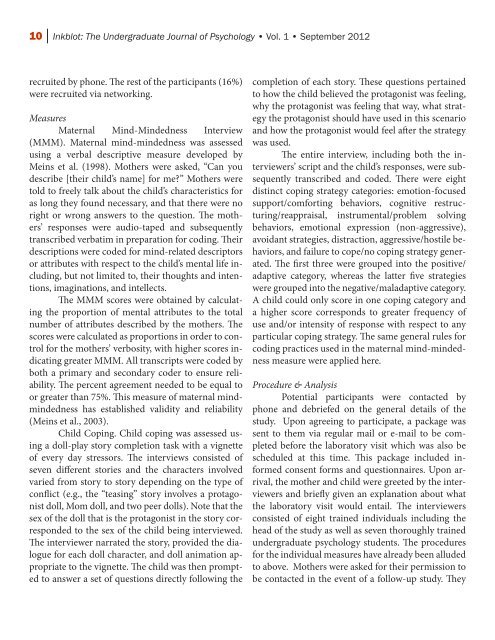7-17-Claire-Banga-Maternal-Mindedness
7-17-Claire-Banga-Maternal-Mindedness
7-17-Claire-Banga-Maternal-Mindedness
Create successful ePaper yourself
Turn your PDF publications into a flip-book with our unique Google optimized e-Paper software.
10 | Inkblot: The Undergraduate Journal of Psychology • Vol. 1 • September 2012<br />
recruited by phone. The rest of the participants (16%)<br />
were recruited via networking.<br />
Measures<br />
<strong>Maternal</strong> Mind-<strong>Mindedness</strong> Interview<br />
(MMM). <strong>Maternal</strong> mind-mindedness was assessed<br />
using a verbal descriptive measure developed by<br />
Meins et al. (1998). Mothers were asked, “Can you<br />
describe [their child’s name] for me?” Mothers were<br />
told to freely talk about the child’s characteristics for<br />
as long they found necessary, and that there were no<br />
right or wrong answers to the question. The mothers’<br />
responses were audio-taped and subsequently<br />
transcribed verbatim in preparation for coding. Their<br />
descriptions were coded for mind-related descriptors<br />
or attributes with respect to the child’s mental life including,<br />
but not limited to, their thoughts and intentions,<br />
imaginations, and intellects.<br />
The MMM scores were obtained by calculating<br />
the proportion of mental attributes to the total<br />
number of attributes described by the mothers. The<br />
scores were calculated as proportions in order to control<br />
for the mothers’ verbosity, with higher scores indicating<br />
greater MMM. All transcripts were coded by<br />
both a primary and secondary coder to ensure reliability.<br />
The percent agreement needed to be equal to<br />
or greater than 75%. This measure of maternal mindmindedness<br />
has established validity and reliability<br />
(Meins et al., 2003).<br />
Child Coping. Child coping was assessed using<br />
a doll-play story completion task with a vignette<br />
of every day stressors. The interviews consisted of<br />
seven different stories and the characters involved<br />
varied from story to story depending on the type of<br />
conflict (e.g., the “teasing” story involves a protagonist<br />
doll, Mom doll, and two peer dolls). Note that the<br />
sex of the doll that is the protagonist in the story corresponded<br />
to the sex of the child being interviewed.<br />
The interviewer narrated the story, provided the dialogue<br />
for each doll character, and doll animation appropriate<br />
to the vignette. The child was then prompted<br />
to answer a set of questions directly following the<br />
completion of each story. These questions pertained<br />
to how the child believed the protagonist was feeling,<br />
why the protagonist was feeling that way, what strategy<br />
the protagonist should have used in this scenario<br />
and how the protagonist would feel after the strategy<br />
was used.<br />
The entire interview, including both the interviewers’<br />
script and the child’s responses, were subsequently<br />
transcribed and coded. There were eight<br />
distinct coping strategy categories: emotion-focused<br />
support/comforting behaviors, cognitive restructuring/reappraisal,<br />
instrumental/problem solving<br />
behaviors, emotional expression (non-aggressive),<br />
avoidant strategies, distraction, aggressive/hostile behaviors,<br />
and failure to cope/no coping strategy generated.<br />
The first three were grouped into the positive/<br />
adaptive category, whereas the latter five strategies<br />
were grouped into the negative/maladaptive category.<br />
A child could only score in one coping category and<br />
a higher score corresponds to greater frequency of<br />
use and/or intensity of response with respect to any<br />
particular coping strategy. The same general rules for<br />
coding practices used in the maternal mind-mindedness<br />
measure were applied here.<br />
Procedure & Analysis<br />
Potential participants were contacted by<br />
phone and debriefed on the general details of the<br />
study. Upon agreeing to participate, a package was<br />
sent to them via regular mail or e-mail to be completed<br />
before the laboratory visit which was also be<br />
scheduled at this time. This package included informed<br />
consent forms and questionnaires. Upon arrival,<br />
the mother and child were greeted by the interviewers<br />
and briefly given an explanation about what<br />
the laboratory visit would entail. The interviewers<br />
consisted of eight trained individuals including the<br />
head of the study as well as seven thoroughly trained<br />
undergraduate psychology students. The procedures<br />
for the individual measures have already been alluded<br />
to above. Mothers were asked for their permission to<br />
be contacted in the event of a follow-up study. They



